This is a follow up piece on the blog post that I published last week – Part 1: How to Say NO with Confidence, not guilt.
Since writing the first segment, I’ve fielded an online survey and facilitated a discussion with a group of professional women attending the Women in Business (WIB) Summit Lunch and Greet. It’s been a very interesting exploration.
The Power of NO
I’ve also done more reading on the topic of saying NO. I found particular value in the article “The Power of No” published in Psychology Today by Judith Sills, PhD.
The author encourages us not to confuse the word “NO” with the word “negativity”, as they are not the same. Whereas negativity is an ongoing attitude, the author emphasizes that….
Why this is important
Learning to say NO with confidence is important because, now more than ever, there are so many demands on our time and energy. We can’t continue to say YES to everything. It’s unsustainable, unproductive and unhealthy.
I believe that we need to heighten our conscious awareness and more carefully choose what we say YES to and what we say NO to….while also maintaining positive relationships with ourselves and with others that we care about.
For the next 28 days, I want you to develop strategies and start “practicing” to say NO with confidence. I want you to observe the results – both the internal feelings and the external reactions.
If you do this, you will increase your happiness, gain more time and energy, and make greater progress toward what’s really important to you. You will feel more empowered!
SURVEY RESPONSES
“I’ve wondered why women have more trouble saying no than men do. Thankfully, I don’t have a problem saying no. I’m very aware of “my plate” and not letting it get too full. I can’t do something well when I’m stressed out. Also, if I don’t take care of me, then I can’t be any good for others.” – Kimberly
“Saying NO is something that I’ve mastered lately and I’m loving it. You have to ask yourself if you say YES to this, then what are you saying NO to? Feeding your soul is a personal priority.” – Linda
“I remember reading an interesting article in an academic journal by Anne Sigismund Huff. She said, ‘We must learn to say no. It is critical that we learn more effective ways of denying requests to become involved in secondary activities. I keep a file of ‘no’ letters and am trying to get better at using them.’ ” – Rowena
“When I have said no and explained that I’m at full capacity by using the full plate analogy, I’ve experienced positive feedback – people appreciate an honest NO more than an unfulfilled or poorly executed YES.”- Kimberly
“Let the person know your decision as soon as possible. Provide a short rationale and if possible, recommend someone who would jump at the offer.” – Linda
The Psychology behind saying YES and NO
I am not a Psychologist, but I am a motivator and I like to study what motivates people. I find that there are two gravitational forces of motivation: pleasure and pain. We either move towards what we want (pleasure) or we move away from what we don’t want (pain). Both motivations are powerful. The towards motivation tends to lead to progress, whereas the away from motivation tends to stop short of progress, but will keep you feeling “safe.”
During the WIB Summit Lunch and Greet, we had a discussion about the psychology behind saying YES and NO.
- Relationships. For people we know well, we don’t want to let them down or disappoint them. With people we are trying to get to know, we want them to like us. With strangers, we don’t want to appear to be a jerk.
- Responsibility. When no one else steps up to the plate, you may feel an obligation to take on more work or else it won’t get done. Two counterproductive philosophies- “If you want something done, give it to a busy person.” and “If you want something done right, then do it yourself.”- can lead you to piling on more work and letting others off the hook. The division of labor is often imbalanced. People who are overly responsible tend to suffer the most from this.
- Security. When your boss asks you to do something, there is unspoken pressure that you have no choice. If you refuse, you might lose your job, or miss out on a promotion, or be viewed negatively. If you are working for a big client (Wal-Mart, for example), the client has significantly more POWER than you do. If you are in distribution or sales, etc., you may have to do what is asked of you, even if it is unreasonable, unprofitable, and not in your best interest.
- Competition. We may perceive a limited supply of opportunities and therefore feel an intense sense of competition. We make often try to make ourselves look good by taking on more than we can handle, even when doing so can backfire.
- Social Pressure. There are unspoken forces out there that are very real, including peer pressure, guilt, shame, obligation, embarrassment, exclusion, comparison, etc. There may be very real consequences, such as social consequences, to saying NO to something.
- Cultural Expectations. With regard to saying YES and NO, be aware of the customs and unspoken rules in different cultures. One woman told us that in her home country of Iran, it is considered rude to give a direct answer: NO to a dinner invitation, for example. Instead you shape your response in such as way that it shows the deepest respect and appreciation for the invitation.
Strategies and Best Practices for Saying NO
So what can be done about this? The professional women at the WIB Summit Lunch and Greet offered these suggestions for strategies and best practices for saying NO with confidence.
- Trust your instinct. If you feel this not a good deal for you, say no. You don’t have to explain yourself or feel bad about your decision.
- Become shame resilient. Study the work of Dr. Brené Brown, author of The Power of Vulnerability. (listen to her TED talk) We often say YES to things that we really want to say NO to, and then feel bad about ourselves. Also – people will throw shame and guilt our way to pressure us into saying YES.
- 24 Hour Wait Period. Set a personal policy of not making immediate decisions on any major requests. Instead, give yourself at least 24 hours to reflect on the opportunity and consider your options. “I would like some time to fully consider your offer. I’ll get back to you in 24-48 hours. Is that okay?”
- Ask more questions. Before you give your answer, ask as many questions about the opportunity as possible. Act like a journalist and find out the facts first, before announcing your position or decision.
- Conduct a Cost/Benefit Analysis. More than just weighing the pros and cons, for major decisions, conduct a more through assessment of the true costs and potential benefits that may arise from your decision.
- Know your true value. Do your research and understand the market value of your services, talent, products, etc. Don’t let others set your value with their low-ball offers. Before you say YES or NO, negotiate the deal. Always know your walk-away point. And remember, there are many more opportunities out there. This is just one.
- Vocal Power. Increase your vocal awareness. Practice saying NO with greater vocal power and confidence. Practice saying NO in front of a mirror. Make sure that your body language is congruent with your message and that your tone of voice is clear and strong. Please do not use Upspeak when giving your answer.
- Tell them in person. Have the courage to stand firmly behind your decision. Give your answer in person or over the telephone. Do not default to the more passive communication methods such as texting or emailing your answer. Also, give your answer relatively promptly, so that they are not waiting forever for your decision.
- Honesty. Be honest with yourself first. Examine your feelings, motivations, thoughts, fears, concerns, hopes, etc. Know what is driving you inside. Then it is possible to bring your whole self to the decision and make a good choice – whether it’s yes or no. Honor yourself first. Self-care is part of this equation.
Accepting other people’s NO decisions
While it’s not easy to say NO, it’s equally not easy to hear NO, especially if you are the boss or parent or some other “authority figure.”
If you truly want to empower your people, whether they are your children, your employees, or your friends, you must be willing to gracefully accept their NOs to your offers and asks.
Be aware of when you are using your power to pressure them to say YES to you. There’s a fine line between persuasion, motivation and manipulation.
If you want to inspire engagement, empowerment, and fellowship, you will have to learn to accept NO from your people.
What do you want to say YES to?
The real crux of learning to say NO is knowing more clearly what you want to say YES to in your life. YES and NO are decisions. They help to attract opportunities in your life – either good ones or bad ones.
I encourage you to spend some time reflecting on the kinds of opportunities you would like to say YES to. The more specific you can be about this, the more likely you are to get it.
In networking, when you can tell current network friends specifically which new people you are looking to meet, it is more likely that you will be helped.
If you talking with your boss or mentor and can tell that important person what you want to do in your career, business and/or life, they are more likely to be able to help you make that happen.
And while it’s good to be open to spontaneity and unplanned opportunities that might come your way, the more you know about what you value and what you want to create in your life, the higher the probability of its manifestation.
Know how to say NO
In closing, knowing your value means you need to be able to say NO with confidence and YES with clarity.
I encourage you to say YES to yourself and to say NO to the nonessential. Do so with full confidence and consciousness. It’s your choice.
Click to read Part 1 in this two-part blog post>


